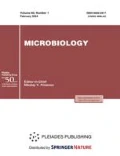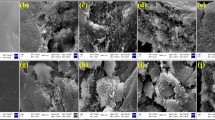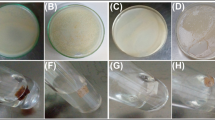Abstract
Natural rubber latex is one of the problems that raises the environmental concerns. In this study the degrading ability of Ficus elastica rubber latex by a bacterium strain ASU-03, isolated from Egyptian soil was assessed. The strain was able to produce clear zone around its colony on latex rubber containing medium and was identified by conventional methods as Streptomyces sp. Phylogenetic analysis of 16S rRNA (16S rRNA) and RNA polymerase ß-subunit (rpoB) genes were applied. Results of the 16S rRNA gene analysis revealed that the strain was highly related to Streptomyces sp. (100% similarity), so the rpoB gene was partially sequenced to clarify the specific name of the isolate. Phylogenetic tree based on rpoB gene sequences indicated that strain ASU-03 was highly similar to the reference strain Streptomyces labedae and both were shared a one cluster. The current results demonstrated that the use of a rpoB gene-based method gives a better resolution in the species level identification. To our knowledge, this species has never been reported to be involved in natural rubber degradation. This was therefore the first report about the degradation of Ficus elastic by S. labedae. The degradation of Ficus elastica rubber latex was determined by measuring the increase in protein content of bacterium (mg/g dry wt), reduction in molecular weight (g/mol) and inherent viscosity (dL/g) of the latex. Moreover the degradation was also confirmed by formation of aldehyde or keto group by Schiff’s reagent and by observing the growth of the Streptomyces strain using scanning electron microscopy.
Similar content being viewed by others
References
Rifaat, H.M. and Yosery, M.A., Identification and characterization of rubber degrading Actinobacteria, Appl. Ecol. Environ. Res., 2004, vol. 2, pp. 63–70.
Rose, K. and Steinbuchel, A., Biodegradation of natu-ral rubber and related compounds; recent insights into hardly understood catabolic capability of microorgan-isms, Appl. Environ. Microbiol., 2005, vol. 2, pp. 2803–2812.
Bröker., D., Arenskötter, M., Legatzki, A., Nies, D.H., and Steinbüchel, A., Characterization of the 101-kilo-base-pair megaplasmid pKB1 isolated from the rub-ber-degrading bacterium Gordonia wetfalicia Kb1, J. Bacteriol., 2004, vol.2, pp. 212–225.
Rose, K., Tenberge, K.B., and Steinbüchel, A., Identi-fication and characterization of genes from Streptomyces sp. strain K30 responsible for clear zone formation on natural rubber latex and poly (cis-1,4-isoprene) rub-ber degradation, Biomacromolecules, 2005, vol. 2, pp. 180–188.
Ibrahim, E.M., Arenskotter, M., Luftmann, H., and Steinbuchel, A., Identification of poly cis-1,4 iso-prene degradation intermediates during growth of moderately thermophilic actinomycetes on rubber and cloning of a functional Kp homologue from Nocardia farcinia strain E, Appl. Environ.Microbiol., 2006, vol. 2, pp. 3375–3382.
Warneke, S., Arenskötter, M., Tenberge, K.B., and Bhowmick, A.K., Bacterial degradation of poly (trans-1,4-isoprene) (gutta percha), Microbiology (UK), 2007, vol. 2, pp. 347–356.
Bröker, D., Dietz, D., Arenskötter, M., and Stein-büchel, A., The genomes of non-clearing-zone-form-ing and natural rubber-degrading species Gordonia polyisoprenivorans and Gordonia westfalica harbor genes expressing Lcp activity in Streptomyces strains, Appl. Environ. Microbiol., 2008, vol. 2, pp. 2288–2297.
Yikmis, M., Arenskötter, M., Rose, K., and Lange, N., Wernsmann, H., Wiefel, L., and Steinbüchel, A., Secretion and transcriptional regulation of the latex-clearing protein, Lcp, by the rubber degrading bacterium Streptomyces sp. Strain K30, Appl. Environ. Microbiol., 2008, pp. 5373–5382.
Arenskötter, M., Baumeister, D., Berekaa, M.M., Pöt-ter, G., Kroppenstedt, R.M., Linos, A. and Stein-büchel, A., Taxonomic characterization of two rubber degrading bacteria belonging to the species Gordonia polyisoprenivorans and analysis of hypervariable regions of 16S rDNA sequences, FEMS Microbiol. Let., 2001, vol. 2, no. 3, pp. 277–282.
Hesham, A., Mohammed, N.H., Ismail, M.A., and Shoreit, A.A., 16S rRNA gene sequences analysis of Ficus elastic rubber latex degrading thermophilic Bacillus strain ASU7 isolated from Egypt, Biodegradation, 2012, vol. 2, pp. 717–724.
Wititsuwannakul, D. and Wititsuwannakul, R., Bio-chemistry of natural rubber and structure of latex, in Biopolymers, Polyisoprenoids, Koyama T. and Stein-buchel, A., Eds., Wiley–VCH, Germany, 2001, vol. 2, pp. 151–201.
Kang, H., Kang, M.Y., and Han, K.H., Identification of natural rubber and characterization of rubber biosyn-thetic activity in fig tree, Plant Physiol., 2000, vol. 2, pp. 1133–1142.
Heisey, R.M. and Papadatos, S., Isolation of microor-ganisms able to metabolize purified natural rubber, Appl. Environ. Microbiol., 1995, vol. 2, pp. 3092–3097.
Lowery, O.H., Rosebrough, N.H., Farr, A.L., et al., Protein measurement with the Folin phenol reagent, J. Biol. Chem., 1951, vol. 2, pp. 291–297.
Aly, K. I., Wahdan, H., and Hussein, A.M., New poly-mer syntheses, part 43: novel polyamides-based dia-rylidenecyclopentanone: synthesis, characterization and corrosion inhibition behaviour, J. Appl. Polymer Sci., 2009, vol. 2, pp. 513–523.
Linos, A., Berekka, M.M., Reichett, R., and Randall, R.J., Biodegradation of cis 1,4 polyisoprene rubbers by distinctactinomycetes: microbial strategies and detailed surface analysis, Appl. Environ. Microbiol., 2000, vol. 2, pp. 1639–1645.
Ehrlich, G., Taylor, H.E., and Waelsch, H., The effect of surface-active substances on the fuchsin reaction of higher fatty aldehydes, J. Biol. Chem., 1948, vol. 2, pp. 547–551.
Sneath, P.H.A., Bergey’s Manual of Systematic Bacteri-ology, vol. 2, Baltimore: Williams and Wilkins, 1986.
Hesham, A., New safety and rapid method for extraction of genomic DNA from bacteria and yeast strains suitable for PCR amplifications. J. Pure Appl. Microbiol., 2014, vol. 2, no. 3, pp. 383–388.
Lane, D.J., 16S/23S rRNA sequencing, in Nucleic Acid Techniques in Bacterial Systematics, Stackebrandt, E. and Goodfellow, M., Eds., New York: Wiley, 1991, pp. 115–175.
Kim, B.J., Kim, C.J., Chun, J., and Koh, Y.H., Lee, S.H., Hyun,.W., Cha, C.Y., and Kook, Y.H., Phy-logenetic analysis of the genera Streptomyces and Kitasatospora based on partial RNA polymerase b-subunit gene (rpoB) sequences, Int. J. Syst. Evol. Microbiol., 2004, vol. 2, pp. 593–598.
Tsuchii, A., Takeda, K., and Tokiwa, Y., Degradation of the rubber in truck tyres by a strain of Nocardia, Biodeg-radation, 1996, vol. 2, pp. 405–413.
Roy, R.V., Das, M., Banerjee, R., et al., Comparative studies on rubber biodegradation through solid-state and submerged fermentation, J. Process Bioch., 2006, vol. 2, pp. 181–186.
Bode, H.B., Zeeck, A., Pluckhahn, K., and Jen-drossek, D., Physiological and chemical investigations into microbial degradation of synthetic poly (cis-1,4-isoprene), Appl. Environ. Microbiol., 2000, vol. 2, pp. 3680–3685.
Braaz, R., Fischer, P., and Jendrossek, D., Novel type of heme-dependent oxygenase catalyzes oxidative cleav-age of rubber (poly-cis-1,4-isoprene), Appl. Environ. Microbiol., 2004, pp. 7388–7395.
Spence, D. and Van-Niel, C.B., Bacterial decomposi-tion of the rubber in Hevea latex, Ind. Eng. Chem., 1936, vol. 2, pp. 847–850.
Nette, I. T., Pomortseva, N.V., and Kozlova, E.I., Destruction of rubber by microorganisms, Microbi-ologiya, 1959, vol. 2, pp. 821–827.
Bode, H.B., Kerkhoff, K., and Jendrossek, D., Bacte-rial degradation of natural and synthetic rubber, Bio-macromolecules, 2001, vol. 2, no. 3, pp. 295–303.
Tsuchii, A. and Tokiwa, Y., Microbial degradation of tyre rubber particles, Biotechnol. Lett., 2001, vol. 2, pp. 963–969.
Kumar, Y. and Goodfellow, M., Reclassification of Streptomyces hygroscopicus strains as Streptomyces aldersoniae sp. nov., Streptomyces angustmyceticus sp. nov., comb. nov., Streptomyces ascomycinicus sp. nov., Streptomyces decoyicus sp. nov., comb. nov., Streptomyces milbemycinicus sp. nov. and Streptomyces wellingto-niae sp. nov., Int. J. Syst. Evol. Microbiol., 2010, vol. 2, pp. 769–775.
Imai, S., Ichikawa, K., Muramatsu, Y., Kasai, D., Masai, E., and Fukuda, M., Isolation and characteriza-tion of Streptomyces, Actinoplanes, and Methylibium strains that are involved in degradation of natural rub-ber and synthetic poly(cis-1,4-isoprene), Enz. Microb. Technol., 2011, vol. 2, pp. 526–531.
Tamura, T., Oguchi, A., Kikuchi, T., Kikuchi, H., Nishii, T., Tsuji, K., Yamaguchi, Y., Tase, A., Taka-hashi, M., Sakane, T., Suzuki, K.I., and Hatano, K., Phylogenetic study of the species within the family Streptomycetaceae, A. van Leeuwenhoek, 2012, vol. 2, pp.73–104.
Dahllof, I., Baillie, H., and Kjelleberg, S., rpoB-based microbial community analysis avoids limitations inher-ent in 16S rRNA gene intraspecies heterogeneity, Appl. Environ. Microbiol., 2000, vol. 2, pp. 3376–3380.
Ueda, K., Seki, T., Kudo, T., Yoshida, T., and Kataoka, M., Two distinct mechanisms cause hetero-geneity of 16S rRNA, J. Bacteriol., 1999, vol. 2, pp. 78–82.
Han, J., Cho, M., and Kim, S., Ribosomal and protein coding gene based multigene phylogeny on the family Streptomycetaceae, Syst. Appl. Microbiol., 2012, vol. 2, pp. 1–6.
Author information
Authors and Affiliations
Corresponding author
Additional information
The article is published in the original.
Rights and permissions
About this article
Cite this article
Hesham, A.EL., Mohamed, N.H., Ismail, M.A. et al. Degradation of natural rubber latex by new Streptomyces labedae strain ASU-03 isolated from Egyptian soil. Microbiology 84, 351–358 (2015). https://doi.org/10.1134/S0026261715030078
Received:
Published:
Issue Date:
DOI: https://doi.org/10.1134/S0026261715030078




